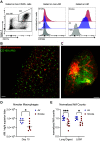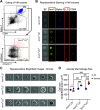Cigarette smoke depletes alveolar macrophages and delays clearance of Legionella pneumophila
- PMID: 36719079
- PMCID: PMC10026984
- DOI: 10.1152/ajplung.00268.2022
Cigarette smoke depletes alveolar macrophages and delays clearance of Legionella pneumophila
Abstract
Legionella pneumophila is the main etiological agent of Legionnaires' disease, a severe bacterial pneumonia. L. pneumophila is initially engulfed by alveolar macrophages (AMs) and subvert normal cellular functions to establish a replicative vacuole. Cigarette smokers are particularly susceptible to developing Legionnaires' disease and other pulmonary infections; however, little is known about the cellular mechanisms underlying this susceptibility. To investigate this, we used a mouse model of acute cigarette smoke exposure to examine the immune response to cigarette smoke and subsequent L. pneumophila infection. Contrary to previous reports, we show that cigarette smoke exposure alone causes a significant depletion of AMs using enzymatic digestion to extract cells, or via imaging intact lung lobes by light-sheet microscopy. Furthermore, treatment of mice deficient in specific types of cell death with smoke suggests that NLRP3-driven pyroptosis is a contributor to smoke-induced death of AMs. After infection, smoke-exposed mice displayed increased pulmonary L. pneumophila loads and developed more severe disease compared with air-exposed controls. We tested if depletion of AMs was related to this phenotype by directly depleting them with clodronate liposomes and found that this also resulted in increased L. pneumophila loads. In summary, our results showed that cigarette smoke depleted AMs from the lung and that this likely contributed to more severe Legionnaires' disease. Furthermore, the role of AMs in L. pneumophila infection is more nuanced than simply providing a replicative niche, and our studies suggest they play a major role in bacterial clearance.
Keywords: Legionella pneumophila; alveolar macrophages; cigarette smoking; pyroptosis.
Conflict of interest statement
No conflicts of interest, financial or otherwise, are declared by the authors.
Figures







Similar articles
-
IFNγ receptor down-regulation facilitates Legionella survival in alveolar macrophages.J Leukoc Biol. 2020 Feb;107(2):273-284. doi: 10.1002/JLB.4MA1019-152R. Epub 2019 Dec 2. J Leukoc Biol. 2020. PMID: 31793076 Free PMC article.
-
Epigallocatechin gallate, a potential immunomodulatory agent of tea components, diminishes cigarette smoke condensate-induced suppression of anti-Legionella pneumophila activity and cytokine responses of alveolar macrophages.Clin Diagn Lab Immunol. 2002 Jul;9(4):864-71. doi: 10.1128/cdli.9.4.864-871.2002. Clin Diagn Lab Immunol. 2002. PMID: 12093687 Free PMC article.
-
Replicative Legionella pneumophila lung infection in intratracheally inoculated A/J mice. A murine model of human Legionnaires' disease.Am J Pathol. 1994 Dec;145(6):1537-46. Am J Pathol. 1994. PMID: 7992856 Free PMC article.
-
Viewing Legionella pneumophila Pathogenesis through an Immunological Lens.J Mol Biol. 2019 Oct 4;431(21):4321-4344. doi: 10.1016/j.jmb.2019.07.028. Epub 2019 Jul 25. J Mol Biol. 2019. PMID: 31351897 Free PMC article. Review.
-
Molecular pathogenesis of infections caused by Legionella pneumophila.Clin Microbiol Rev. 2010 Apr;23(2):274-98. doi: 10.1128/CMR.00052-09. Clin Microbiol Rev. 2010. PMID: 20375353 Free PMC article. Review.
Cited by
-
Distribution of drug-resistant genes in alveolar lavage fluid from patients with psittacosis and traceability analysis of causative organisms.Front Microbiol. 2023 Jun 22;14:1182604. doi: 10.3389/fmicb.2023.1182604. eCollection 2023. Front Microbiol. 2023. PMID: 37425996 Free PMC article.
References
Publication types
MeSH terms
Associated data
LinkOut - more resources
Full Text Sources
Medical
Molecular Biology Databases

